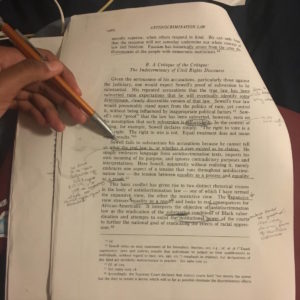
I often find that Princeton professors assume that we all know how to “read critically.” It’s a phrase often included in essay prompts, and a skill necessary to academic writing. Maybe we’re familiar with its definition: close examination of a text’s logic, arguments, style, and other content in order to better understand the author’s intent. Reading non-critically would be identifying a metaphor in a passage, whereas the critical reader would question why the author used that specific metaphor in the first place. Now that the terminology is clarified, what does critical reading look like in practice? I’ve put together a short guide on how I approach my readings to help demystify the process.
- Put on your scholar hat. Critical reading starts before the first page. You should assume that the reading in front of you was the product of several choices made by the author, and that each of these choices is subject to analysis. This is a critical mindset, but importantly, not a negative one. Not taking a reading at face value doesn’t mean approaching the reading hoping to find everything that’s wrong, but rather what could be improved.
- Revisit Writing Sem: Motive and thesis are incredibly helpful guides to understanding tough academic texts. Examining why the author is writing this text (motive), provides a context for the work that follows. The thesis should be in the back of your mind at all times to understand how the evidence presented proves it, but simultaneously thinking about the motive allows you to think about what opponents to the author might say, and then question how the evidence would stand up to these potential rebuttals.
- Get physical. Take notes! Critical reading involves making observations and insights—track them! My process involves underlining, especially as I see recurring terms, images, or themes. As I read, I also like to turn back and forth constantly between pages to link up arguments. I was reading a longer legal text for a class and found that flipping back and forth helped me clarify the ideas presented in the beginning of the text so I could track their development in later pages.
- Play Professor. While I’m reading, I like to imagine potential discussion or essay topics I would come up with if I were a professor. These usually involves examining the themes of the text, placing this text in comparison or contrast with another one we have read in the class, and paying close attention to how the evidence attempts to prove the thesis.
- Form an (informed) opinion. After much work, underlining, and debating, it’s safe to make your own judgments about the author’s work. In forming this opinion, I like to mentally prepare to have this opinion debated, which helps me complicate my own conclusions—a great start to a potential essay!
Critical reading is an important prerequisite for the academic writing that Princeton professors expect. The best papers don’t start with the first word you type, but rather how you approach the texts composing your essay subject. Hopefully, this guide to reading critically will help you write critically as well!
–Elise Freeman, Social Sciences Correspondent

